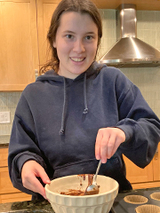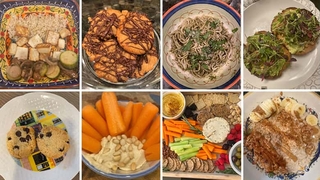Life with Celiac Disease: Anna’s Story
Life with Celiac Disease: Anna’s Story

Anna, a 17-year-old Girl Scout from Abington, Pa., created a guide: “What Every Teenager Needs to Know About a Celiac Diagnosis,” as part of her pursuit of the Girl Scouts of USA’s highest achievement, the Gold Award.
After sharing the guide with her clinical team at the Center for Celiac Disease at Children’s Hospital of Philadelphia’s Center (CHOP), clinical leaders decided to share it here for other teens to benefit from Anna’s first-person account of celiac disease – from diagnosis to acceptance, and the lifestyle changes she’s made along the way.
“I created this guide because I want to give a teenager’s perspective of being diagnosed with celiac disease and how best to live with it,” Anna writes, “I want this be a resource for children and teenagers adapting to a gluten-free lifestyle.”
My health journey
As a child, I had stomach problems, but they were not severe. I didn’t think there was anything wrong with me because the stomach issue would eventually go away.
Going into my teenage years, I started to go out to eat more with my friends and family; and my condition worsened. I was tired frequently, and often went to the nurse during school to sleep.
At first, I assumed I was lactose intolerant because when I ate dairy, I would get abdominal pains. I consulted my pediatric doctor who said it is very common for people to not be able to digest dairy properly. So, I cut dairy out of my diet. But my stomach problems did not go away.
My parents took my symptoms seriously. They took me to see Pediatric Gastroenterologist Kevin J. Kelly, MD, at CHOP Specialty Care, Abington. I got a blood panel for potential food sensitivities. Dr. Kelly explained that if I tested positive for celiac disease on the blood panel, he’d need to confirm the finding with an endoscopy. I tested positive.
Dr. Kelly recommended that I eat gluten-free to see how I felt. After a week or so of being gluten-free, I felt so much better, I had more energy and my stomach hurt less.
My endoscopy was scheduled for early December 2020. During the procedure, a thin, flexible tube was inserted into my mouth with a light and camera on the end. I didn’t feel anything because I was under anesthesia.) The endoscope let my doctors see down my throat, into my esophagus, stomach and beginning of my small intestine. They took some tissue samples and when the results came back, I was diagnosed with celiac disease. At first, I was upset with my diagnosis. But I also knew if I did what my clinical team recommended, my health would improve and ultimately, I’d feel better.
Coming to terms with celiac diagnosis
When I first got my diagnosis, I was really concerned about how it would change my life. At first, I was overwhelming and stressful. I felt like I’d been eating a certain way – with foods I liked – all my life and was very used to it. Now, I’m told I can’t do that anymore?
We may not notice it, but food is a big part of our lives. Not only does it sustain us and give us energy, it’s also part of the way we socialize with family and friends. I worried: How would I be able to adapt?
I’m writing this guide because I’ve been where you are now. Everyone's story has meaning, and I hope by sharing mine, it will give you the confidence to know you’ll learn to adapt too.
Dining out – searching for “safer” options
When I was diagnosed with celiac disease, one of the first things I thought about was eating out at restaurants. Food plays an important role in socialization – especially for teens. We come together and socialize around food. Though there are some challenges dining out with celiac disease, there are a lot “safer” food options today. Food allergies and food intolerances have become much more common; and customers have asked for ingredients about what they are eating.
In years to come, it will be even easier. But preparation is key. When going out with friends, I recommend looking at the menu beforehand and calling the restaurant to assess if they can accommodate your dietary needs. If there’s not something on the menu that you can safely eat, try advocating for yourself and helping restaurant staff understand that you are allergic to gluten. I also recommend packing a snack so it the restaurant is not as accommodating or safe as you had hoped, you can still eat with your friends.
Many restaurants now have a separate area for preparing gluten-free foods so they are not accidently contaminated by crumbs or foods that do contain gluten. When I go to new places or travel, I often use the app FindMeGlutenFree which has user reviews on celiac disease safety, quality of food and other dietary restrictions. If you can’t find anything on the app, I often find Mexican food can accommodate gluten-free diets with corn tortillas.
Eating gluten-free at home and pantry set-up

If you have celiac disease, it’s important to try to keep gluten away from the food you’ll eat. This can be challenging in a household where you have some people with gluten allergies and some with none. Gluten contamination happens very easily in a typical kitchen. When possible, purchase new pans, cutting boards and appliances dedicated to gluten-free meal prep. The only appliance I invested in is a new toaster for my gluten-free bread.
It is optimal to create a space for your gluten-free products in one area in the kitchen and not to mix gluten and non-gluten products. I reorganized my family's pantry and I have two shelves dedicated to my gluten-free stuff. There are many new gluten-free alternatives on the market, but they tend to be a bit more expensive. I invest in the gluten-free alternatives that I eat almost every day. Buying your food staples on a budget is very possible. These may include rice, quinoa, beans, potatoes, corn tortillas and chips. Most fruits and vegetables are naturally gluten-free.
Sharing your diagnosis and life-style changes
Telling friends and family about your diagnosis and new gluten-free lifestyle is important. By helping them better understand the disease and how gluten negatively affects you, they can better support you. When I tell people about my diagnosis, I explain how I was diagnosed: with a blood test and an endoscopy. My condition is real, and I cannot eat gluten or I will suffer uncomfortable side effects.
The more people I told, the easier it became to share. Today, I’m comfortable telling a stranger I have celiac disease, while I was hesitant at first to even tell those closest to me.
Celiac disease impacts you physically, but there is also a mental component. I struggled with anxiety about going to restaurants or eating at a friend’s house. Once they understand my diagnosis, I have found people to be very supportive. Many even go out of their way for me.
Gluten-free baking: What I’ve learned
Gluten-free baking can be challenging. When trying a new recipe, I recommend following the directions exactly. Don’t substitute ingredients unless you are prepared to deal with the consequences.
My favorite gluten-free flours are almond, oat and any kind of 1-to-1 baking flour. A 1 to 1 baking flour is a direct substitute for all-purpose flours with a combination of starches and rice flours. My personal favorites are Bob's Red Mill or King Arthur.
Flours made from almond, coconut and hazelnut tend to be denser, and need more binding with eggs. Oat and 1-to-1 flour blends, tend to be like all-purpose flour but also may need more liquid (oil or milk) because it can turn out dry. From my experience, I tend to have better luck with things like cookies, brownies and pies. I find baking bread challenging. It's hard to achieve the right texture without gluten.
Some food inspiration
Below are some of my favorite gluten-free meals and snacks (Images from left to right).
- Bowl with brown rice, crispy tofu and sauteed veggies.
- Peanut butter cookies with chocolate on top. (like peanut butter blossoms)
- Pasta with pesto and fresh basil. My favorite pasta is chickpea or brown rice.
- Avocado toast with microgreens and pine nuts.
- Almond Flour Chocolate Chip Cookies
- Hummus and carrots. You can substitute gluten-free crackers or gluten-free chips to dip.
- This was my Thanksgiving dairy free cheese board with Simple Mills Crackers and Mary’s Gone Crackers.
- Almond Butter Banana Oats

Before trying, please refer to our Recipe Disclaimer.
Anna is a patient at Children’s Hospital of Philadelphia. She enjoys cooking, baking, skiing, going into Philadelphia and visiting museums. Anna is an ambassador Girl Scout and is pursuing the Gold Award, the highest achievement within the Girl Scouts of the USA, and comparable to the Boy Scouts of America’s Eagle Scout.